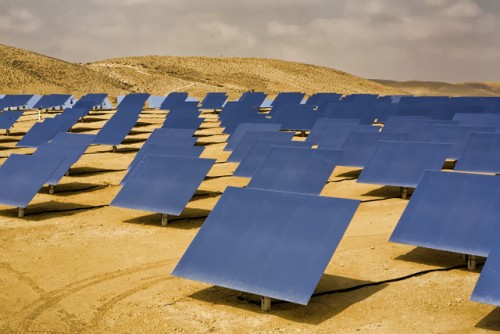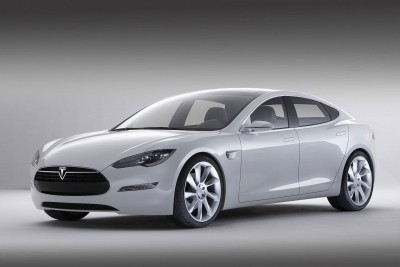 A BrightSource Energy solar thermal project.Photo: BrightSource EnergyDrive around the San Francisco Bay Area and you can see the emerging corporate infrastructure of the new green economy.
A BrightSource Energy solar thermal project.Photo: BrightSource EnergyDrive around the San Francisco Bay Area and you can see the emerging corporate infrastructure of the new green economy.
In a downtown Oakland office tower, you’ll find the headquarters of BrightSource Energy, a solar thermal power-plant developer that has scored contacts to build more than 2,600 megawatts’ worth of solar farms. Off Highway 101 in the Silicon Valley suburb of San Carlos, Tesla Motors is developing its next electric car. Down the road in Palo Alto, Shai Agassi‘s Better Place is designing regional electric-car charging networks and battery-swapping stations for Australia, Canada, Denmark, Israel, and the United States.
Backing those companies is VantagePoint Venture Partners. The venture capital firm is making big bets on green tech by funding nearly two dozen startups involved in everything from LED lighting to algae biofuels to water to the smart grid. Given VantagePoint’s vantage on the emerging green economy, I paid a visit to the firm’s headquarters in decidedly unglamorous San Bruno (known to most Bay Area residents as the home of the long-term airport parking lot) to chat with CEO Alan Salzman.
 VantagePoint CEO Alan Salzman.A veteran VC who currently manages nearly $5 billion in investments, Salzman, 55, had recently returned from Copenhagen, where he attended the World Business Summit on Climate Change. That alone should tell you how much Silicon Valley has changed in recent years. VCs didn’t used to jet off to Scandinavian capitals to talk policy with international bureaucrats.
VantagePoint CEO Alan Salzman.A veteran VC who currently manages nearly $5 billion in investments, Salzman, 55, had recently returned from Copenhagen, where he attended the World Business Summit on Climate Change. That alone should tell you how much Silicon Valley has changed in recent years. VCs didn’t used to jet off to Scandinavian capitals to talk policy with international bureaucrats.
The game was, as Salzman explained, relatively simple. “We and most of the Valley had an attitude toward Washington: ‘We won’t ask for anything; therefore you’ll leave us alone.’ It worked pretty well.”
That, of course, is the part of Silicon Valley’s enduring foundation myth that tends to gloss over the defense dollars and government R&D that provided the seed capital that transformed Santa Clara Valley into Silicon Valley. And tech emissaries have for years periodically flown East to lobby for foreign-worker visa programs and other government goodies.
But back then a Google could go from garage to global powerhouse without too much thought about Washington policymakers. Not any more. The fortunes of VantagePoint’s portfolio of green tech companies will, to varying degrees, rise and fall with regulatory policy.
“I think as we approach the energy sector and industries with a high degree of regulation, such as anything to do with a utility, building codes, and transportation, we have no alternative but to engage in the political process because those areas are highly politicized,” says Salzman, sporting chinos and a white polo shirt with the VantagePoint logo.
 Tesla Model S sedan.Tesla, for instance, last month scored a $465 million Department of Energy loan guarantee that will let the electric automaker build its next car, the Model S sedan. BrightSource, meanwhile, has applied for a DOE loan guarantee to help finance its first solar power plant.
Tesla Model S sedan.Tesla, for instance, last month scored a $465 million Department of Energy loan guarantee that will let the electric automaker build its next car, the Model S sedan. BrightSource, meanwhile, has applied for a DOE loan guarantee to help finance its first solar power plant.
And Silicon Valley lobbied hard for a change in the tax code that allows renewable energy companies the option to take as cash a 30 percent investment tax credit. (The Wall Street investment banks that once bankrolled such projects by tapping the tax credit have become as endangered as the California pika that’s scrambling up Sierra mountaintops to escape global warming.)
Salzman argues that Silicon Valley needs a seat in Washington not just to protect its economic interests but also to ensure that regulators make the right choices when it comes to renewable energy and other technology-driven policies.
“We think there’s a real need, a real void in some ways, in Washington for the understanding of the role of the innovator,” he says. “We worry a great deal that policy is being made without a realization of what’s doable from a technology viewpoint. If you’re setting standards and you don’t have a clear view where we are on the technology evolution, you’re at great risk of making terrible policies that address yesterday’s problems”
VantagePoint, according to Salzman, targets industries most ripe for transformation to address tomorrow’s problems and then places bets on startups it thinks can accelerate that process. And for the next decade or two that means clean tech — energy, transportation, and water.
“That’s where the large important new companies are going to come from, primarily,” he says. “There will still be the Facebooks of the world, but I think you can’t today name the leading solar thermal company — well, I can as it’s our company — but most people can’t. Can you name the leading LED lighting companies today or the Cisco of green building materials?”
Just don’t get him started on Detroit.
“For half the cost of what we gave to GM and Chrysler, we could have created huge domestic industries around batteries and electric drive trains and given our guys jobs in Detroit and Alabama instead of propping up a dying industry so the Chinese can build the electric car industry.”
“The Prius is now in its third generation,” he adds. “So GM spots Toyota, the best car company in the world, a 12-year head start and then comes out with a competitive product that’s going to be priced at two times. So you wonder who came out with that as a winning strategy.”
“If a startup showed up here and said, ‘Right, we’ll spot the best company in the world a 12-year leap and we’re going to come out with a comparable product at twice the price,’ it wouldn’t be a long meeting.”
While Salzman thinks no “Google of the grid” will emerge, owing to the complexity of the electricity distribution system, that may not be the case with large-scale solar thermal energy. (Solar thermal farms generate power by using mirrors to focus the sun’s heat on liquid-filled boilers to create steam to drive turbines.)
Electricity is a commodity and whoever can sell the cheapest electrons wins, he argues.
“You might prefer Bing over Google, but nobody says, ‘I’m really tired of those 10-cent-a-kilowatt-hour electrons, I’m going to go for those 12-cent-a-kilowatt-hour electrons to have a mix,'” he says. “It really is winner take all.”
Of course, in highly regulated energy markets, the winner also will be determined by those companies that successfully navigate a Byzantine licensing process and get their power plants in production to begin to achieve economies of scale.
While he’s an evangelist for the transformative powers of green tech, Salzman is no tree hugger out to change the American way of consumption.
“We don’t think the American way of life wants to have less,” says Salzman. “If you want to drive a big, frickin’ SUV that holds 14 people, knock yourself out. But do it in a way that doesn’t put CO2 in the atmosphere or the other carcinogens coming out the back. Do it in a way that you’re using electrons that are safe and harmless and make those electrons using sunshine, wind, and renewable energy. Then who cares what you’re driving? Let someone haul their soccer team around if it doesn’t cause harm — why wouldn’t you?”
Read past Green State columns by Todd Woody.




